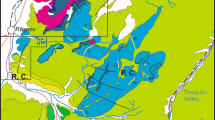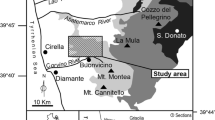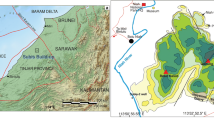Summary
Analysis of parasequences of carbonate platform origin from the Calcari Grigi Formation (Rotzo Member, Lower Jurassic) in the Venetian Pre-Alps of Northern Italy reveals intense burrowing affecting warm lagoonal and protected shelf environments of the Trento carbonate platform. The trace fossil pattern suggests a strong biogenic activity by many unknown organisms (episodic surficial bioturbation) and by decapod crustaceans (deep burrowing) during the Sinemurian—Pliensbachian. Burrow networks ofThalassinoides (T. suevicus, type I to IV) andOphiomorpha form three-dimensional systems (3DBS), up to 150 cm in thickness, that reveal well developed taphonomic characteristics. Occasionally, also rare body fossil remains (exuvia) ofPhlyctisoma (Erymidae) are preserved, although it is very difficult to attribute to this decapod crustacean a real tracemaker activity. In a total of 18 shallowing-upward taphosequences, each 2.3–2.6 m in thickness, the lower, subtidal part (BOP: base of parasequence), is invariably characterized by 3DBS. Three parts of a 3DBS are taphonomically relevant: a) the enlargement at bifurcation points (the so-called turning chambers) with related tunnel sections in horizontal networks; b) the distribution of vertical tunnels and their openings, locally associated with biogenic mounds; and c) the infilling with coarse-grained skeletal debris of abandoned burrows (tubular tempestites). Case (a), although well known in the literature, is nevertheless peculiar because of the exceptional diameter (up to 22 cm) and shape of bifurcations ofThalassinoides suevicus. Therefore their taphonomic analysis helps to refine shallowing-upward taphosequences. Case (b) and (c), instead, are exceptional because traces of the activity of decapod crustaceans at the sea-floor are very rare in the geologic record. The 3DBS involve taphofacies that are peculiar of the upper part of the Calcari Grigi across western Venetian Prealps. The analysis of 3DBS in all Lower Jurassic para-sequences will aid sequence stratigraphy and the paleoenvironmental reconstruction of the carbonate platform setting.
Similar content being viewed by others
References
Ager, D.V. (1981): Major marine cycles in the Mesozoic.—J. Geol. Soc., London,138 (2), 159–166. London
Aigner, T. (1985). Storm depositional systems: Dynamic stratigraphy in modern and ancient shallow-marine sequences.—In: Friedman, G.M., Neugebauer, H.J. and A. Seilacher (eds.): Lecture notes in Earth Sciences3, 174 pp., Berlin (Springer)
Anderson, L.C. and McBride, E. (1996): Taphonomic and palaeoenvironmental evidence of Holocene shell-bed genesis and history on the northeastern Gulf of Mexico shelf.—Palaios,11, 532–549, Tulsa
Anderson, B.G. and Droser, M.L. (1998): Ichnofabrics and geometric configurations of Ophiomorpha within a sequence stratigraphic framework: an example from the Upper Cretaceous US Western Interior.—Sedimentology,45, 379–396, Amsterdam
Beccarelli Bauck, L. (1988): Unter-bis mitteljurassische Karbonatformationen am Westrand der Trento-Platform (Südalpen, Norditalien).—Münchener Geowissenschaftliche Abhandlungen,13, 1–86, München
Benini, C. and Loriga, C. (1974):Isognomon (Mytiloperna) v. Ihering 1903 eGervilleioperna Krumbeck 1923 fra i grossi lamellibranchi della facies a “Lithiotis” del Veneto.—Acc. Naz. Lincei, Rend. s.8,57,3–4, 233–243, Roma
Berti Cavicchi, A., Bosellini, A. and Broglio Loriga, C. (1971): CalcariaLithiotis problematica Gümbel o calcari a “Lithiotis”? —Mem. Geopaleont. Univ. Ferrara,15/1, 41–53, Ferrara
Bosellini, A. and Broglio Loriga, C. (1971): I “Calcari Grigi” di Rotzo (Giurassico inferiore, Altopiano di Asiago) e loro inquadramento nella paleogeografia e nella evoluzione tettono-sedimentaria delle Prealpi Venete.—Ann. Univ. Ferrara s.9,5/ 1, 1–61, Ferrara
Bosellini, A. and Hardie, L.A. (1985): Facies e cicli della Dolomia Principale delle Alpi Venete.—Mem. Soc. Geol. It.,30, 245–266, Roma
Braithwaite, C.J.R. and Talbot, M.R. (1972): Crustacean burrows in the Seychelles, Indian ocean.—Palaeogeogr. Palaeoclimatol. Palaeoecol.,11, 265–285, Amsterdam
Brett, C.E. (1995): Sequence stratigraphy, biostratigraphy, and taphonomy in shallow marine environments.—Palaios,10, 597–616, Tulsa
Brett, C.E. and Baird, G.C. (1986): Comparative taphonomy: a key to paleoenvironmental interpretation based on fossil preservation. —Palaios,1, 207–227, Tulsa
Broglio Loriga, C. and Neri, C. (1976): Aspetti paleobiologici e paleogeografici della facies a “Lithiotis” (Giurese inf.).—Riv. Ital. Paleont. Strat. Mi.,82/4, 651–706, Milano
Broglio Loriga, C., Fugagnoli, A and Pignatti, P. (1996): Gastropod-dominated communities from Lower Jurassic (Calcari Grigi, Trento platform, northern Italy).—XIII Convegno S.P.I., Parma 1996, 67–68, Parma
Broglio Loriga, C. and Fugagnoli, A. (1997): Nerineacean dominated communities from lower Jurassic shallow water carbonates (Calcari Grigi, Trento platform; northeastern Italy).— GEOITALIA 1° forum FIST, Bellaria, 5–9 ott. 1997,2, sess. 6, 67–68, Bellaria.
Bromley, R.G. (1970): Borings as trace fossils andEntobia cretacea Portlock, as an example.—In: Crimes, T.P. and Harper, J.C. (eds.): Trace Fossils.—Geol. Journ. Spec. Issue3, 49–90. Liverpool (Seal House)
Bromley, R.G. (1996): Trace fossils. Biology, taphonomy and applications (2nd ed.).—361 pp., London (Chapman and Hall)
Caldwell, R. and Dingle, H. (1976) Stomatopods.—Scientific American,234/1, 80–89, New York
Caracuel, J.E., Monaco, P. and Olóriz, F. (2000): Taphonomic tools to evaluate sedimentation rates and stratigraphic completeness in Rosso Ammonitico Facies (epioceanic tethyan Jurassic).—Riv It. Paleont. Strat., Mi,106/3, 353–368, Milano
Claps, M. (1993) Ciclicità ad alta frequenza nella piattaforma carbonatica dei Calcari Grigi (Prealpi Venete, Giurassico Inferiore): evidenze di controllo eustatico.—Unpublished PhD Thesis, Università degli Studi, Parma.
Clari, P. (1975): Carateristiche sedimentologiche e paleontologiche di alcune sezioni dei Calcari Grigi del Veneto.—Mem. Degli Istit. Geol. e Mineral. Dell'Univ. di Padova,31, 1–63, Padova
Curran, H.A. (1994): The palaeobiology of ichnocoenoses in Quaternary, Bahamian-style carbonate environments: the modern to fossil transition.—In: Donovan, S.K. (ed.): The Palaeobiology of Trace Fossils.—308, 83–104. New York (Wiley).
Davis, Jr., R.A., Knowles, S.C. and Bland, M.J., (1989): Role of hurricanes in the Holocene stratigraphy of estuaries: examples from the Gulf coast of Florida.—J. Sedim. Petrol.,59/ 6, 1052–1061, Tulsa
Deacon, K., Last, P., McCosker, J.E., Taylor, L., Tricas, T.C. and Walker, T.I. (1998): Gli squali.—Ist. Geogr. De Agostini S.p.A., 288 p. Novara
Donaldson, D. and Simpson, S. (1962):Chomatichnus, a new ichnogenus, and other trace fossils of Wegber Quarry. Liverpool and Manchester.—Geol. Journ.,3, 73–80, Liverpool
Dott, R.H. and Bourgeois, J. (1982): Hummocky stratification: significance of its variable bedding sequences.—Geol. Soc. of Americ. Bull.,93, 663–680, Boulder
Duke, W.L. (1985). Hummocky cross-stratification, tropical hurricanes, and intense winter storms.—Sedimentology,32, 167–194, Oxford.
Dworschak, P.C. and Ott, J.A. (1993): Decapod burrows in mangrove-channel and back-reef environments at the Atlantic Barrier Reef, Belize.—Ichnos2 277–290, Amsterdam
Einsele, G., Ricken, W. and Seilacher, A. (1991): Cycles and Events in Stratigraphy.—955 pp., Heidelberg (Springer)
Ekdale, A.A., Bromley, R.G. and Pemberton, S.G. (1984): Ichnology —Trace Fossils in Sedimentology and Stratigraphy.—SEPM Short Courses,15, 317 pp., Tulsa
Fernández López, S. (1997a): Ammonites, clinos, tafonómicos y ambientes sedimentarios.—Revista Española de Paleont.,12/1, 102–128, Madrid
Fernández López, S. (1997b): Ammonites, clinos tafonómicos y y ciclos estratigráficos en plataformas epicontinentales carbonáticas.—Revista Española de Paleont.,12/1, 151–174, Madrid
Frey, R.W. and Howard, J.D. (1970): Comparison of Upper Cretaceous ichnofaunas from siliceous sandstones and chalk, Western Interior Region, U.S.A.—In: Crimes, T.P. and Haroper, J.C. (eds.): Trace Fossils.—Geol. Journ. Spec. Issue3, 141–166, Liverpool
Frey, R.W., Howard, J.D. and Pryor W.A. (1978): Ophiomorpha: its morphologic, taxonomic, and environmental significance.— Palaeogeogr. Palaeoclimatol. Palaeoecol.,23, 199–229, Amsterdam
Fugagnoli, A. and Loriga Broglio, C. (1996): Revised biostratigraphy of Lower Jurassic shallow water carbonates from the Venetian Prealps (Calcari Grigi, Trento Platform, Northern Italy).—Studi Trentini di Sci. Naturali, Acta Geologica, Trento,73, 35–73, Trento
Fürsich, F.T. (1979): Genesis, environments and ecology of Jurassic hardgrounds.—N. Jb. Geol. Paläont. Abh.158/1, 1–63, Stuttgart
Fürsich, F.T. (1998): Environmental distribution of trace fossils in the Jurassic of Kachchh (Western India).—Facies,39, 243–272, Erlangen
Fürsich, F.T. and Oschmann, W. (1993): Shell beds as tools in basin analysis: the Jurassic of Kachchh, western India.—J. Geol. Soc. London,150, 169–185, London
Gagan, M.K., Johnson, D.P. and Carter, R.M. (1987): The cyclone Winifred storm bed, central Great barrier reef shelf, Australia. —J. Sedim. Petrol.,58, 5, 845–856, Tulsa
Ginsburg, R.N. (1975): Tidal deposits: a casebook of recent examples and fossil counterparts.—428 pp., Berlin (Springer).
Goldring, R. (1995): Organisms and the substrate: response and effect.—In: Bosence, D.W.J. and Allison, P.A. (eds.): Marine Palaeoenvironmental analysis from Fossils.—Geol. Soc. Spec. Publ.83, 151–180, London
Goldring, R. and Pollard, J.E. (1993): Organisms and sediment: relationships and applications.—J. Geol. Soc., London,150, 137–139, London
Grant, W.D. and Madsen, O.S. (1986): The continental shelf bottom-boundary layer.—Annual Review Fluid Mechanics18, 265–305.
Haq, B.U. (1991): Sequence stratigraphy, sea-level change, and significance for the deep sea.—Spec. Publs. Int. Ass. Sediment.,12, 3–39, Tulsa
Haq, B.U., Hardenbol, J. and Vail, P.R. (1988): Mesozoic and cenozoic chronostratigraphy and cycles of sea-level change.— In: Wilgus, C.K., Hastings, B.S., Posamentier, H. Van Wagoner, J. Ross, C.A. and Kendall C.G.St. (eds.): Sea-level changes: an integrated approach.—Soc. of Econ. Paleont. and Miner., Spec. Publ.42, 71–108, Tulsa
Häntzschel, W. (1975): Trace Fossils and Problematica.—In: Teichert, C. (ed.): Treatise on Invertebrate Paleontology, W,— 269 pp. Boulder (Geol. Soc. of America)
Hardie, L.A. and Shinn, E.A. (1985): Carbonatetidal flats. Carbonate depositional environments: modern and ancient.—Short Course, Colorado School of Mine, Golden, 1–155, Boulder
Harms, J.C. (1969): Hydraulic significance of some sand ripples.—Geol. Soc. Amer. Bull.80, 363–396, Boulder
Harms, J.C., Southard, J.B., Spearing, D.R. and Walker, R.G. (1975): Depositional environments as interpreted from primary sedimentary structuress and stratification sequences.—Soc. Econ. Paleont. Mineral., Tulsa, Short Course2, 161 pp., Tulsa
Hasiotis, S.T. and Mitchell, C.E. (1993): A comparison of crayfish burrow morphologies: Triassic and Holocene fossil, paleo- and neo-ichnological evidence, and the identification of their burrowing signatures.—Ichnos,2, 291–314, Amsterdam
Hof, C.H.J. (1998): Fosssil stomatopods (Crustacea: Malacostraca) and their phylogenetic impact.—J. Natural Hist.,32, 1567–1576, London
Hof, C.H.J. and Briggs, D.E.G. (1997): Decay and mineralization of mantis shrimps (Stomatopoda: Crystacea)—A key to their fossil record.—Palaios,12, 420–438, Amsterdam
Holzapfel, S. (1998): Palökologie benthischer Faunengemeinschaften und Taxonomie der Bivalven in Jura von Südtunesien.—Beringeria,22, 3–199, Würzburg
Hubbard, D.K. (1992): Hurricane-induced sediment transport in open-shelf tropical systems-an example from St. Croix, U.S. Virgin Islands.—J. Sedim. Petrol.,62/6, 946–960, London
Kidwell, S.M. (1991): Taphonomic feedback (livedead interactions) in the genesis of bioclastic beds: keys to reconstructing sedimentary dynamics.—In: Einsele, G., Ricken, W. and Seilacher, A. (eds.), Cycles and Events in Stratigraphy.—268–282, Berlin (Springer)
Kidwell, S.M. and Fürsich, F.T. and Aigner, T. (1986): Conceptual framework of the analysis and classification of fossil concentrations.—Palaios,1, 228–238, Amsterdam
Kreisa, R.D. (1981): Storm-generated sedimentary structures in subtidal marine facies with examples from the middle and upper Ordovician in southwestern Virginia.—Journ. of Sediment. Petrol.,51/3, 823–848, Amsterdam
Kuhn, O. (1973). Die Tierwelt des Solnhofener Schiefers. 119 p., Wittemberg Lutherstadt (Die Neue Brehm-Bücherei)
Leckie, D. (1988). Wave-formed, coarse-grained ripples and their relationship to hummocky cross-stratification.—J. Sediment. Petrol.58/4, 607–622, Tulsa
Macchioni, F., Monaco, P. and Parisi, G. (1996): Some taphonomic features of ammonites internal moulds in the Early Toarcian of Rosso Ammonitico in central-western Umbria, Italy.—Reunion sobre Tafonomia y Fosilizacion “Taphos 96”, Zaragoza 13–15, Junio 1996, 175–180. Zaragoza
Manning, R.B. (1995): Stomatopod Crustacea of Vietnam: The Legacy of Raoul Serène. Crustacean Research Spec. Numb.4 (Tokyo: The Carcinological Society of Japan), 339 p. Tokyo
Marsaglia, K.M. and Klein, G. de V. (1983): The paleogeography of Paleozoic and Mesozoic storm depositional system.—J. Geology,91, 117–142, Boulder
Masetti, D., Claps, M., Giacometti, A., Lodi, P. and Pignatti, P. (1988): I Calcari Grigi della Piattaforma di Trento (Lias inferiore e medio, Prealpi Venete).—Atti Ticinensi di Scienze della Terra, Univ. di Pavia, Ed. New Press,40, 139–183. Pavia
Myrow, P.M. and Southard, J.B. (1996): Tempestite deposition.—Journ. Sedim. Res.,66/5, 875–887, Tulsa
Monaco, P. (1992): Hummocky cross-stratified deposits and turbidites in some sequences of the Umbria-Marche area (central Italy) during the Toarcian.—Sedimentary Geology,77, 123–142, Amsterdam
Monaco, P. (1994): Hummocky cross-stratifications and trace fossils in the Middle Toarcian of some sequences of Umbria-Marche Apennines.—Geobios,17, 679–688, Villeurbanne
Monaco, P. (1995): Relationships between trace-fossil communities and substrate characteristics in some Jurassic pelagic deposits in the Umbria-Marche basin, central Italy.—Geobios,18, 299–311, Villeurbanne
Monaco, P. (1999): Computer database as a tool to investigate taphonomy and events in carbonate platform environments.—In: Farinacci, A. and Lord, A. (eds.): Depositional Episodes and Bioevents.—Paleopelagos, Spec. Publ.2, 1999, 105–122, Roma
Monaco, P. (1999b): Taphonomic characteristics and biological overprints in the Calcari Grigi, Pliensbachian, Trento platform (northern Italy).—Riv. Mus. Civ. Sci. Nat. “E. Caffi” Bergamo,20 (1999), 137–138, Bergamo
Monaco, P. (2000): Biological and physical agents of shell concentrations ofLithiotis facies enhanced by microstratigraphy and taphonomy, Early Jurassic, Gray limestones, Formation, Trento area (Northern Italy).—In: Hall, R.L. and Smith P.L. (eds.): Advances in Jurassic Research 2000.—Proceedings of the Fifth International Symposium on the Jurassic System, Vancouver BC, GeoResearch Forum6, 473–486, Basel (Trans Tech.)
Monaco, P. (2000b): Decapod burrows (Thalassinoides, Ophiomorpha) and crustacean remains in the Calcari Grigi, lower Jurassic, Trento platform (Italy).—1st Workshop on Mesozoic and Tertiary decapod crustaceans, Studi e Ricerche, Ass. Am. Museo Civ. “G.Zannato”, Montecchio Maggiore (Vi), 6 Ott. 2000, pp. 55–57, Vicenza
Monaco, P. (2001): Tiered ichnoassemblages in Jurassic tempestites from Apennines and Southern Alps.—Boll. Soc. Geol. It., Vol. Spec.1 (2001), Roma
Monaco, P. and Giannetti, A. (2001): Stratigrafia tafonomica nel Giurassico Inferiore dei Calcari Grigi della Piattaforma di Trento.—Atti Ticinensi di Scienze della Terra, Pavia,42, 175–209, Pavia
Monaco, P. and Garassino, A. (2001): Burrowing and carapace remains of crustacean decapods in the Calcari Grigi, Early Jurassic, Trento platform.—Geobios34/3, 291–301, Villeurbanne
Nauss, A.L. and Smith, P.L. (1988):Lithiotis (bivalvia) bioherms in the Lower Jurassic of east-central Oregon, U.S.A..—Palaeogeogr. Palaeoclimatol. Palaeoecol.,65, 253–268, Amsterdam
Neumann, A.C. (1966): Observations on coastal erosion in Bermuda and measurements of the boring rate of the sponge Cliona Lampa.—Limnol. Oceanogr.,11, p. 92, Durham
Oschmann, W. (1995): The Posidonia shales (Toarc, Lower Jurassic) in SW-Germany.—III EPA Workshop “Black shales models”, Coord. by M. Jäger, W. Oschmann, and A. Seilacher, Dotternhausen (Germany), July 6–8, 1995, 4–23. Dotternhausen
Pemberton, S.G. (1992): Applications of Ichnology to petroleum exploration (a core workshop).—SEPM core workshop17, 429 p., Calgary.
Perkins, R.D. and Enos, P. (1968): Hurricane Betsy in the Florida-Bahama area, Geologic effects and comparison with Hurricane Donna.—J. Geology,76, 710–717, Chicago
Praturlon, A. (1968): Cycadophyta and Coniferophyta from the Lias of M. Palombo (Marsica, central Apennines).—Geologica Romana7, 1–26, Roma
Reaka, M.L. and Manning, R.B. (1987): The significance of body size, larval dispersal, and habitat for rates of morphological evolution in stomatopod Crustacea.—Smithsonian Contributions to Zoology,44, 1–46, Washington
Rieth, A. (1932): Neue Funde spongeliomorpher Fucoiden as dem Jura Schwabens.—Geologische und Paläontologische Abhandlungen, N.F.,19, 257–294, Stuttgart
Snedden, J.W., Nummedal, D. and Amos, A.F. (1988): Storm-and fair-weather combined flow on the central Texas continental shelf.—J. Sediment. Petr.,58/4, 580–595, Tulsa
Stamhuis, E.J., Reede-Dekker, T., van Etten, J., de Wiljes, J.J. and Videler, J.J. (1996): Behaviour and time allocation of the burrowing shrimpCallianassa subterranea (Decapoda, Thalassinidea).—J. Experim. Marine Biol. Ecol.,204, 225–239, Amsterdam
Swift, D.J.P., Figueiroda, A.G., Jr., Freeman, J.L. and Oetel, G.F. (1983): Hummocky cross-stratification and mega-ripples. A geologic double standard?.—J. Sediment. Petrol.,53, 1295–1318, Tulsa
Swinbanks, D.D. and Luternauer, J.L. (1987): Burrow distribution of thalassinidean shrimp on a Fraser delta tidal flat, British Columbia.—J. Paleont.,61/2, 315–332, Tulsa
Vera, J.A. and Molina, J.M. (1998): Shallowing-upward cycles in pelagic troughs (Upper Jurassic, Subbetic, Southern Spain).— Sedimentary Geology,119, 103–121, Amsterdam
Walker, R.G., (1979). Shallow marine sands.— In: Walker, R.G. (ed.): Facies Models.—Geosc. Canada, Reprint. Ser. 1 75–89, Kitchener
Wanless, H.R., Tedesco., L.P., Risi, J.A., Bischof, B.G. and Gelsanliter, S. (1995). The role of storm processes on the growth and evolution of coastal and shallow marine sedimentary environments in South Florida.—1th SEPM Congress on sedimentary Geology, Field Trip Guidebook, 179 p. Tulsa
Wanless, H.R., Tedesco, L.P. and Tyrrell, K.M. (1988): Production of subtidal tubular and surficial tempestites by hurricane Kate, Caicos Platform, British West Indies.—Journ. of Sediment. Petrol.58/4, 739–750, Tulsa
Weimer, R.J. and Hoyt, J.H. (1964): Burrows of Callianassa major Say, geologic indicators of littoral and shallow neritic environments.— J. Paleont.,38/4, 761–767, Tulsa
Webb, J.E. and Theodor, J. (1968): Irrigation and submerged marine sands through wave action.—Nature,220, 682–683, London
Wesley, A. (1956): Contributions to the knowledge of the flora of the Grey Limestones of Veneto: Part I. Mem. Ist. Geol. Min. Univ. Padova,19, 1–68, Padova
Wilson, J.L. (1975): Carbonate facies in Geologic history.—471 pp., New York (Springer)
Yagishita, K., Arakawa, S. and Taira, A. (1992): Grain fabric of hummocky and swaley cross-stratification.—Sediment. Geol.,78, 181–189, Amsterdam
Zempolich, W.G. (1993): The drowning succession in Jurassic carbonates of the Venetian Alps, Italy: a record of supercontinent breakup, gradual eustatic rise, and eutrophication of shallow-water environments.—In: Loucks, R.G. and Sarg, J.F. (eds.): Carbonate Sequence Stratigraphy—Recent Developments and Applications.—AAPG Memoir57, 63–105, Tulsa
Author information
Authors and Affiliations
Rights and permissions
About this article
Cite this article
Monaco, P., Giannetti, A. Three-dimensional burrow systems and taphofacies in shallowing-upward parasequences, lower Jurassic carbonate platform (Calcari Grigi, Southern Alps, Italy). Facies 47, 57–82 (2002). https://doi.org/10.1007/BF02667706
Received:
Revised:
Issue Date:
DOI: https://doi.org/10.1007/BF02667706




